Abstract
This study conducted a basic analysis of the supply and demand of aeronautical data communications, focusing on trajectory-based operation (TBO), which is one of the methods used for improving the efficiency of air traffic in the digital transformation era using a scenario analysis. Based on a multi-regional TBO project conducted in June 2023, this study estimated the communication demand in the TBO era using scenario analysis, analyzed supply capacity using the aeronautical data communication infrastructure that is in use at present and also in the future, and considered the feasibility and challenges of implementation. We found that it is feasible to use a satellite communication system with internet technology for digital flight plans and air traffic control (ATC) instructions such as altitude and speed changes, as exchanged during TBO. We quantitatively clarified that further development of communication technology and ingenuity of transmission methods are necessary for larger-volume data, such as weather images, which is useful for situational awareness. By clarifying the communication performance requirements of the on-board and terrestrial communication systems required in the TBO era, this study contributes to the realization of TBO for stakeholders who make reasonable and timely decisions regarding the investment needed to introduce this technology.
1. Introduction
The International Civil Aviation Organization (ICAO), a specialized agency of the United Nations Economic and Social Council on Aviation, developed the Global Air Navigation Plan (GANP) [1] as an aviation strategy document. The GANP [1] outlines strategic directions for operational improvements, including capacity enhancement and efficiency gains, with the goal of achieving interoperability and harmonization across global air traffic management systems. To this end, specific initiatives include the implementation of system-wide information management (SWIM) [2], which facilitates collaborative decision-making and mutual information-sharing among stakeholders. This ensures system and data interoperability while enabling more efficient and optimized operations. Additionally, the GANP [1] promotes the concept of trajectory-based operation (TBO) [3], wherein aircraft flight trajectories are collaboratively planned and coordinated in advance, considering inter-aircraft interference and economic efficiency. Under TBO [3], aircraft are expected to follow these pre-determined trajectories at designated times, thereby enabling more efficient flight paths compared to conventional air traffic management methods. To achieve this, it is necessary to introduce various measures, such as the following:
- (1)
- Accurately determining the aircraft’s position and time during all flight phases, from departure to arrival, and ensuring high-precision, reliable, and flexible navigation performance.
- (2)
- Achieving automation of data communication using fixed phrases for departure/arrival procedures, altitude/speed changes, etc.
- (3)
- Improving predictive ability through forecasting, using advanced calculations and learning functions by utilizing weather data from meteorological satellites and avionics.
- (4)
- Implementing collaborative decision-making with stakeholders by introducing a common information-sharing platform that ensures interoperability.
- (5)
- Achieving high-density flight operations through accurate time management, obtaining information on aircraft dynamics, and minimizing separation by utilizing automatic dependent surveillance between aircraft.
These measures are summarized in the long-term vision for the future air traffic systems [4] of Japan, as shown in Figure 1.
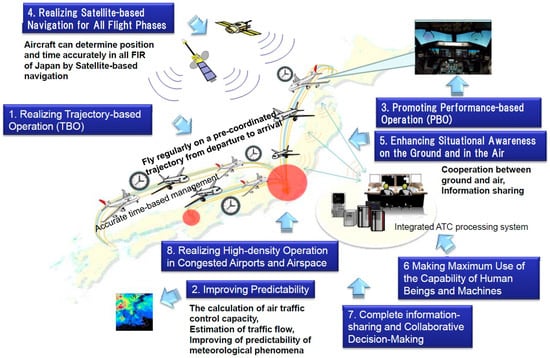
Figure 1.
Image of TBO [3] in the long-term vision for the future air traffic systems in Japan [4].
Compared to conventional air traffic management systems, trajectory-based operation (TBO) [3] aims to reduce fuel consumption and CO2 emissions, as well as improve flight punctuality, by alleviating airspace congestion, minimizing holding times, and maintaining optimal separation distances between aircraft during flight.
To realize these objectives and verify their effectiveness, numerous studies have addressed various aspects of improving airport performance and optimizing global air traffic efficiency. In particular, with regard to the enhancement of airport operations through mutual information-sharing among stakeholders and the implementation of SWIM [2], Guo Xu et al. [5] and Antonio Correas et al. [6] demonstrated the benefits of stakeholder information utilization. Meanwhile, conceptual studies by Xiaodong Lu et al. [7] and Robert Klein et al. [8] highlighted the effectiveness of collaboration with aircraft in achieving these goals.
Furthermore, Biruk Abraham et al. [9], Thien Ngo et al. [10], Diana Liang et al. [11], David William et al. [12], and Aditya Saraf et al. [13] have proposed various methods for and demonstrated the benefits of mutual information exchange and collaborative decision-making among stakeholders.
With respect to trajectory management, various methods for trajectory prediction and generation have been proposed. These include modeling approaches and tree-branching techniques by George Hunter et al. [14], Yizhou Yan et al. [15], Lidong Zhang et al. [16], Keyao Yu et al. [17], Yutong Chena et al. [18], Subramanian Ramasamy et al. [19], Lucas Borges Monteiro et al. [20], Mayara Condé Rocha Murça et al. [21], Yuhang Fan et al. [22], and Alexander Kuenz et al. [23]. Additionally, orbit management methods have been presented by Alicia Fernandes et al. [24], while evaluation techniques for TBO [3] have been proposed by Kenneth Leiden et al. [25] and Roland Sgorcea et al. [26].
In terms of standardization efforts, Roland Sgorcea et al. [27] conducted a gap analysis to identify the technical requirements for TBO [3] implementation. Developments in communication technologies specific to TBO [3] have been presented by Stephen L. Giles et al. [28] and Kazuyuki Morioka et al. [29], while Alessandro Gardi et al. [30] proposed methods to enhance the efficiency of information processing within the TBO [3] framework.
In applied research, Diana Liang et al. [31] and Eric Thomas et al. [32] explored the feasibility of extending TBO [3] concepts to unmanned aircraft systems (UASs).
Despite ongoing research into the conceptual framework, operational benefits, and technical specifications of TBO [3], the actual implementation of these advanced technologies in operational air traffic systems remains limited.
In response to this gap in knowledge, a major demonstration of TBO [3] was conducted in June 2023 under the Multi-Regional TBO (MR TBO) [3,33] initiative, involving aviation authorities from the United States, Singapore, Thailand, and Japan. Using an actual aircraft, the demonstration experiment validated the feasibility of TBO [3] operations and highlighted operational benefits, such as the reduced CO2 emissions resulting from improved fuel efficiency, as confirmed by Diana Liang et al. [34].
Specifically, the demonstration established a SWIM [2]-enabled environment to facilitate the real-time coordination of flight routes and estimated times of arrival from pre-departure to landing. This was achieved by digitizing flight plans and meteorological data and employing air-ground datalink communications to adjust flight paths and timing based on real-time constraints, weather conditions, and trajectory data. The successful execution of a TBO [3] flight under these conditions provided valuable insights into the communication technologies and data requirements needed for TBO [3] operations on international routes.
However, this demonstration focused on achieving TBO [3] using the technologies currently in use and on confirming the effects of improving its operation. Previous studies have not included a detailed analysis of the compatibility between each communication technology and the communication performance requirements currently under consideration by the ICAO. Furthermore, there has been a lack of evaluation of communication supply and demand balance based on projected traffic volumes in the TBO [3] era. This includes future high-speed, high-capacity communication technologies such as LDACS [35] and AeroMACS [36], which are highlighted as key technological enablers in the European ATM Master Plan [37] under SESAR [38] and the U.S. NextGen [39] initiative; these concepts and demonstration studies are shared within the ICNS framework [40].
In light of these gaps, this study conducts a detailed analysis of the multi-regional TBO (MR TBO) [3,33] demonstration scenario, focusing on the communication demands associated with TBO [3] operations for each defined use. Based on these findings, we assess the communication supply capabilities of currently deployed technologies, as well as those technologies expected to be introduced in the near future. A supply-and-demand analysis is then conducted according to the assumed communication performance requirements set forth by the ICAO, taking into account realistic operational scenarios to evaluate the availability and sufficiency of each form of communication technology.
Subsequently, the study proposes potential solutions to address the issues identified through this analysis. Finally, we discuss the broader challenges associated with the societal implementation of TBO [3], with a particular focus on the deployment of advanced communication technologies.
2. Literature Review
Regarding research and development in the field of aviation communications, Sumiya, Y et al. [41] presented an analysis method for the amount of communication and transmission delay when an aircraft on the ocean performs data communication using a time-division multiplexed Inmarsat third-generation geostationary satellite data communication system, while Kitaori, J et al. [42] verified the characteristics of the communication channel of the system. In addition, Morioka, K et al. [43] conducted a development evaluation of the application of switching technology between different aviation communication systems. Eriza Hafid, F et al. [44] verified the realization of air traffic management using multi-satellite spot beams.
In addition, regarding research on unmanned aerial vehicles, which are being implemented in the fields of photography and disaster prevention as a new form of air mobility, Md. Munirul, H et al. [45] proposed utilizing coordinated wireless networks for ground, water, and air. R. Lakshmana, K et al. [46] suggested building a communication network between aircraft as a means of resolving ground communication problems and introducing encryption technology as a means of ensuring security, while Pankaj, K et al. [47] proposed the use of cooperative communication between devices.
However, these studies have focused on the basic technology related to radio wave characteristics and the transmission methods related to data communication for mobile aviation communications and did not provide specific measures for calculating the communication channel capacity at the application level. Furthermore, examining a new communication infrastructure to support future air traffic systems is difficult because the system performance is still in the development stage and communication technologies that can satisfy diverse needs in the future and provide high-capacity communication have not yet been achieved. In addition, the design and operation of existing air traffic control (ATC) communication systems are system-based, which defines the hardware used, such as the systems and devices, and the existing studies mentioned above concentrated on the theory and elemental technology to realize system-based architecture.
In contrast, the design and operation of current and future ATC communication systems are shifting toward a performance-based model that defines the performance requirements, such as the communication round-trip time, rather than the hardware, and these systems will be designed to satisfy new requirements in addition to existing system compliance. It is also necessary to calculate and analyze the communication channel capacity. In Japan, this has not yet been analyzed because a future system is still under consideration. Regarding this unanalyzed point, a previous study [48] analyzed the characteristics of air traffic flow in Japan, envisioned a future air traffic system, identified the available communication technologies, and conducted a supply and demand analysis.
This research is based on the TBO [3] demonstration, applies the previous study’s findings [48], extracts the communication technology necessary for realizing TBO [3] through a supply and demand analysis, identifies any issues, and proposes solutions. We believe that this is a new and unprecedented research perspective.
Based on the above overview and the literature review, a summary matrix of research gaps focusing on communication demand and data sharing related to TBO [3] is presented in Table 1.

Table 1.
Summary matrix of the research gaps centered on communication demand and data sharing related to TBO [3].
3. Overview and Scope of the MR TBO [3,33] and Demand Analysis
This section analyzes the communication demands associated with each scenario (i.e., flight operation) demonstrated in the Multi-Regional TBO (MR TBO) [3,33] simulation conducted in June 2023. In this simulation, events occurring throughout various stages of flight operations were categorized into distinct application cases corresponding to specific operational scenes. The following section provides a detailed content volume analysis of these events, structured according to flight operation phase.
3.1. Content Volume Analysis of the MR TBO [3,33] Demonstration Scenario
To estimate the data volume, the system analyzed each applied case as follows, based on the scenario shown in Figure 2, and considered the amount of content required.

Figure 2.
Applied case study of the MR TBO [3,33] demonstration in June 2023.
- (1)
- Cases 1 to 3: Pre-departure and take-off (around the airport, including the terminal air traffic control area)
In cases 1 to 3, three events were performed: dispatch release, flight plan file, and instrument flight rule (IFR) clearance. Each event was event-driven and did not occur simultaneously but, rather, occurred in a chronological cascade. Thus, the required amount of information was determined by the event with the largest amount of information among the three events, which involved the exchange of information from the flight plan application to its approval, and procedural information was exchanged using simple information, such as applications and permits.
As the amount of information for one flight plan was the largest contributor, it was considered as the amount of information per aircraft.
- (2)
- Case 4: En route (radar area)
In case 4 using ATC, radar vectoring was performed to avoid entering military airspace for training use. This was conducted by controller–pilot data link communications (CPDLC), which is a text-based data link ATC communication system that has already been introduced; therefore, one such message was considered as the amount of information per aircraft.
- (3)
- Case 5: Speed control (oceanic en route)
In case 5, ATC was performed as a speed control. Therefore, cases 4 and 5 were the same. Consequently, this case was also conducted by CPDLC; therefore, one such message was considered as the amount of information per aircraft.
- (4)
- Case 6: Altitude control (oceanic en route)
In case 6, the ATC issued an altitude block request (altitude instruction) via the ATC controller to the aircraft. This means that cases 4 and 6 were the same. Consequently, case 5 was also conducted by CPDLC. Therefore, one such message was considered as the amount of information per aircraft.
- (5)
- Case 7: Flight plan change (oceanic en route)
In case 7, trajectories were monitored to share and manage each aircraft with the relevant stakeholders. Mainly contains route information, which had the same type of content as flight plan data. Therefore, cases 1–3 and 7 were considered to be the same, and one flight plan was considered as the amount of information per aircraft.
- (6)
- Case 8: Sharing meteorological information (oceanic en route)
In case 8, the constraint information for volcanic ash was shared as significant meteorological information (SIGMET), and route updates between the ATC agencies were shared by the ATS interfacility data communications (AIDC) system. The former indicates the airspace within which an aircraft cannot fly owing to volcanic ash, using numerical text information regarding the latitude and longitude, and this was considered as the amount of information per aircraft. Furthermore, because higher-quality image data are expected to be available in the future, this case was estimated separately as an application. However, data regarding the AIDC, which exchanges route updates between the ATC agencies, were not included for data volume estimation because they are ground-to-ground communications and there is no communication with the aircraft.
- (7)
- Case 9: Arrival time coordination (approach airspace/arrival)
In case 9, the ATC controller coordinated the arrival of an aircraft by specifying the calculated time over (CTO). Therefore, cases 4 and 9 were the same. Consequently, case 9 was also conducted by CPDLC. Therefore, one such message was considered as the amount of information per aircraft.
3.2. Estimating Communication Demand
- (1)
- Volume estimation of flight plan data
As illustrated in Figure 3, the flight plan utilized in the TBO [3] era closely resembles the digital flight plan proposed in a previous study [48]. Specifically, it includes essential elements such as aircraft type, operational capabilities (e.g., communication and navigation systems), and the departure and arrival airports used. Based on the number of characters required to represent this information, the data volume is estimated to be approximately 11 Kbits.
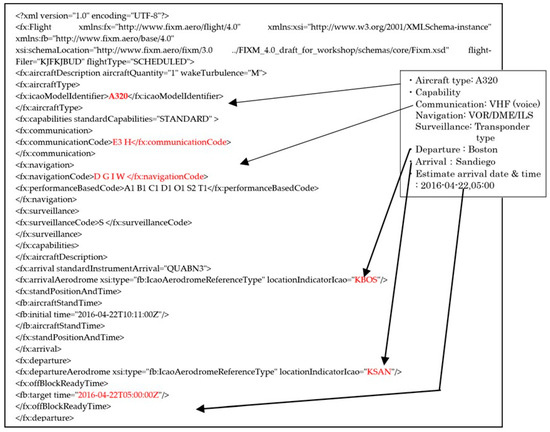
Figure 3.
Example of digital flight plan data.
In addition, TBO [3] requires the inclusion of geographic information—namely, latitude, longitude, and altitude—for each of the aircraft’s waypoints, referred to as FIXs, across all phases of flight. In a representative example of a position report transmitted via controller–pilot data link communications (CPDLC), as described later in this study, the data volume per FIX is approximately 1 Kbit. Given that the case scenario comprises around 20 FIXs, the total data volume associated with these reports is estimated at 20 Kbits.
Taking into account the supplementary data and metadata, the overall data volume required for a complete TBO [3] flight plan is estimated to be approximately 35 Kbits.
Since the current flight plan has a maximum of 1800 characters, it can be converted into 1800 bytes, meaning that the amount of data was 14,400 bits. Even if the current flight plan was estimated to be approximately 15 Kbits by considering the other attached information, the digital flight plan requires a larger amount of data than the current plan. Therefore, in this estimation, digital flight plans were used for the demand analysis.
- (2)
- Volume estimation of text data for ATC
Figure 4 shows an example of text data for the ATC system that is already in operation in oceanic areas. In this case, the actual example of fixed information that is expected to comprise the largest amount of data is approximately 1 Kbits. Therefore, it is estimated to be 1 Kbit.

Figure 4.
Example of actual text data for ATC.
With regard to the anticipated communication congestion caused by random-access transmissions in the terminal airspace near airports, a previous study [48] analyzed traffic volumes at Tokyo Haneda Airport—one of the most congested airports in Japan. However, since the present study focuses on a supply and demand analysis in terms of data volume, this specific issue is beyond the scope of the current discussion.
Nevertheless, it is important to note that TBO [3] inherently aims to reduce such congestion. By considering factors such as aircraft interference and operational efficiency in advance, TBO [3] enables the pre-determined planning and adjustment of aircraft trajectories. Aircraft then fly along these trajectories at designated times, thereby mitigating the likelihood of communication congestion in terminal airspace through prior coordination and planning.
- (3)
- Volume estimation of the NOTAM (volcanic ash information)
Constraint information for volcanic ash covered by the NOTAM (which is a notice filed with an aviation authority to alert aircraft pilots of potential hazards along a flight route or at a location that could affect the flight) was provided in the form of numerical text information indicating the latitude and longitude of the airspace within which the aircraft cannot fly owing to volcanic ash. Figure 5 (left) shows an example of the text data for constraint information regarding volcanic ash provided by the NOTAM, and Figure 5 (right) shows an example of a visualized image based on the text data.
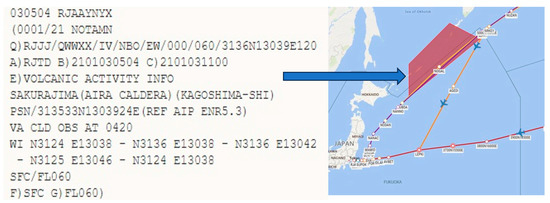
Figure 5.
Example of the text data for the constraint information regarding volcanic ash from the NOTAM (left) and an example of the visualized image based on the text data (right).
- (4)
- Volume estimation from high-quality image data
Regarding the provision of high-quality image data, the amount of data was estimated for each image based on the color tone, gradation, and resolution, which directly affect the amount of data; the results are summarized in Table 2. The amount of image data per image can be estimated using the following formula, which considers each piece of data as 1 bit.
Vs = Co × Gr × Dfv × Dfh (bits)

Table 2.
The volume of image data.
- Vs: Image data amount per image (bits)
- Co: Color tone (bits)
- Gr: Gradation (bits)
- Dfv: Definition vertical (bits)
- Dfh: Definition horizontal (bits)
As a result, because the so-called video graphics array (VGA) resolution was 640 pixels horizontally and 480 pixels vertically, and the color tone was black and white with 8 bits and 256 gradations, each image was 2458 Kbits or approximately 300 KB. Because the color image is expressed using three primary colors, the amount of data was simply tripled to 7373 Kbits or approximately 1 MB. In the case of transmitting more detailed image data, the so-called 2K full high-definition resolution data required 49,766 Kbits per image or approximately 6 MB.
4. Communication Capacity Analysis
Supply analysis investigates and analyzes the communication technology that an aircraft, which is the main component of supply performance, can use for ATC and airline operation.
4.1. Media
To organize communication technologies, media that can be used and is likely to be employed between the present and the 2030s, when the TBO [3] system of the ICAO is expected to be realized, was extracted from the GANP [1]. Table 3 summarizes the comparison of media used for aircraft from the perspective of the requirements necessary for TBO [3], such as transmission speed and coverage.

Table 3.
Comparison of the media used for aircraft.
4.2. Restrictions Experienced During the Calculation of the Supply Amount for Each Transmission Method
A random-access slotted ALOHA method was used as the transmission method using the Internet. This is because the sender transmits data (packets) at an arbitrary time; as the number of users increases, the probability of collision increases. When a collision occurs, the sender waits for a certain “random” period and tries to transmit the data again. If the transmission fails multiple times, the data are retained in the upper layer for retrial. The slotted ALOHA method is an improvement of this method as it provides time synchronization on the sending and receiving sides, such that retransmission processing occurs only when the packets completely collide. Utilizing these techniques, the maximum utilization rate (throughput) is shown in Figure 6. Based on the throughput characteristics, the maximum utilization rate is approximately 36% [49]. All transmission methods are assumed to be implemented using the SWIM [2] infrastructure with the Internet; therefore, this constraint is imposed on the supply and demand analysis. In addition, encryption must be considered from a security perspective in the case of estimating data transmission requirements, but this is not addressed in this study because the impact varies greatly, depending on where the technology is installed. With the existing technology, air traffic control communications use dedicated frequencies to ensure security without affecting the data rates.
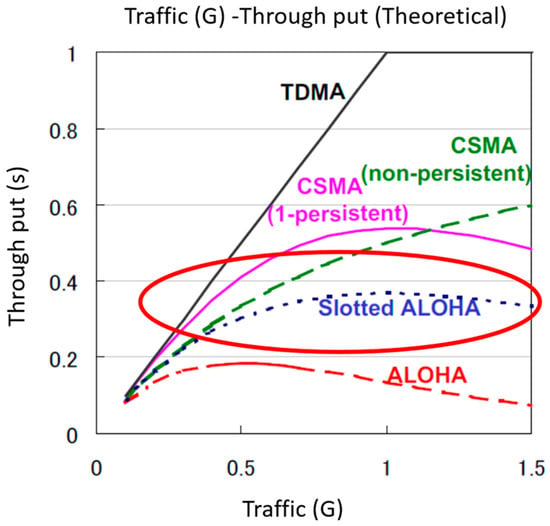
Figure 6.
Characteristics of the through put [49].
5. Supply and Demand Analysis
As clarified in Section 5, the volume of data adopted in this analysis was as follows: (1) flight plan data, (2) text data for ATC, (3) information provision (volcanic ash information), and (4) high-quality images. By comparing these data with the supply amount for each transmission method, we analyzed which one can be used as a communication method for a particular aircraft. Furthermore, if it was possible to process the aircraft, we then calculated how many other aircraft could communicate these data appropriately. In addition, from a security perspective, the increase in the amount of data that occurs due to encryption must be considered when estimating the amount of data involved. However, since such estimates vary greatly, depending on the method and where it is implemented, this is outside the scope of this study. As a side note, currently, security is ensured by using frequencies dedicated to aviation use; with this method, the amount of data does not increase.
5.1. Analysis of Usability as a Means of Transmission
To determine whether each medium can be used, the duration (transmission time) is calculated by dividing the required data volume and the transmission speed, considering the utilization rate, shown in the following formula, which is then compared with the performance requirement time.
Ds = Vs/(Bs × Te)
- Ds (s): Duration
- Bs (bps): Transmission speed
- Te (%): Transmission efficiency
- Vs (bits): Data volume
- (1)
- Flight plan data
In the Japan Civil Aviation Bureau (JCAB) case study, a flight plan is required to be submitted at least 30 min before the flight. There are also no communication performance requirements. However, in the case of TBO [3], we assumed that flight plan data were exchanged on demand in flight by the pilot in the cockpit. Considering this situation in terms of the duration, from the perspective of checking the degree of delay, we examined whether this value exceeded 10 s or 1 min. According to the results, the transmission times that were longer than 10 s were with VHF ACARS, Inmarsat Aero-L (3rd), and Iridium Next; of these, the transmission time of longer than 1 min was for Inmarsat Aero-L (3rd).
- (2)
- ATC (CPDLC)
In continental areas, the ICAO plans to apply the specifications of the required communication performance (RCP) 130 (draft) [50] as the communication performance requirements by utilizing data communication. By complying with this requirement, ATC can safely provide directions for aircraft ascent, descent, and speed adjustment on continental air routes. This calculation is performed to probabilistically examine the round-trip time of communication. For capacity analysis, it is sufficient to evaluate the one-way (call) connection time of the open-ground communication route. In the performance specifications, one-way communication in an open space is defined as the required communication technical performance (RCTP) time, which is set to be within 20 s; for the purposes of this study, we verified whether this value exceeded 20 s. In addition, as RCP240 [51] was applied in an oceanic area, the RCTP was set to 120 s as per the specification, and we examined whether this value exceeded the specification. According to the results, none of the transmission methods exceeded 10 s; even the slowest, Inmarsat Aero-L (3rd), had a transmission time of less than 4 s. Therefore, all media fully met these ICAO communications performance specifications.
- (3)
- NOTAM (Volcanic ash information)
The volcanic ash information distribution has no communication performance requirements. However, in the case of TBO [3], we assumed that flight plan data were exchanged on demand in flight by the pilot in the cockpit from time to time, using the constraint information as a reference. As well as the flight plan data, considering this situation and in order to determine the duration, we examined whether this value exceeded 10 s or 1 min. According to the results, no transmission experienced a delay of more than 1 min, with the slowest, Inmarsat Aero-L (3rd), having a delay of around 13 s.
Regarding the confirmation of transmission duration for each media, the flight plan is shown in Figure 7, the ATC (CPDLC) is shown in Figure 8, and the NOTAM (volcanic ash information) is shown in Figure 9.
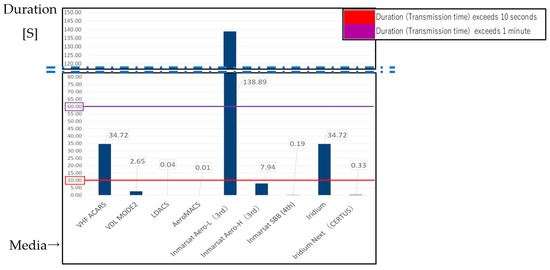
Figure 7.
Confirmation of duration for each of the media: (1) flight plan data.
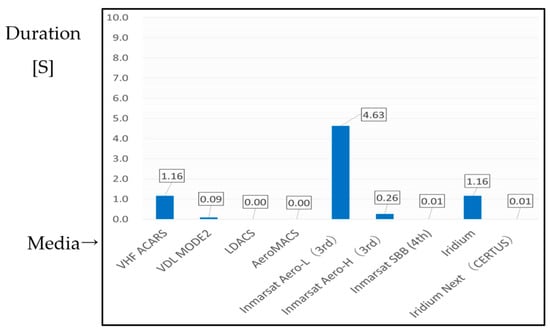
Figure 8.
Confirmation of duration for each of the media: (2) ATC (CPDLC).
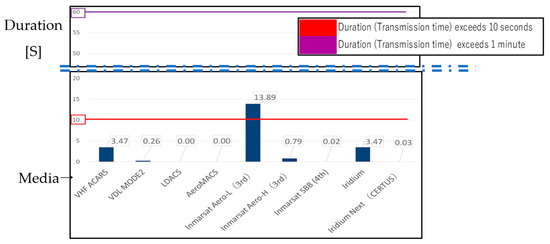
Figure 9.
Confirmation of duration for each of the media: (3) NOTAM (volcanic ash information).
- (4)
- High-quality image data
High-quality image data form part of information-sharing systems such as NOTAM; therefore, there are no communication performance requirements. However, the data volume of a monotone VGA (resolution: 640 × 480 dots) is approximately 2500 Kbits, which is approximately 80 times larger than the amount of flight plan data, which has a text data volume of 30 for TBO [3]. Moreover, the FHD (resolution: 1920 × 1080 dots) with color has a data volume of approximately 50,000 Kbits, which is approximately 1700 times larger than the amount of flight plan data. Therefore, it is easy to imagine that these image data can occupy the entire transmission time/frame. Considering this situation and to determine the duration, we examined whether this value exceeded 10 s or 1 min. From the perspective of comparison, as well as the flight plan data, in order to determine the duration, we examined whether this value exceeded 10 s or 1 min. The comparison of image data is summarized for monotone in Figure 10, and for color in Figure 11. According to the results, in the case of VGA for monotone, all media except LDACS [35], AeroMACS [36], Inmarsat 4th generation SBB, and Iridium Next exceeded 1 min. Furthermore, in the case of XGA, Iridium Next exceeded 1 min, and in the case of FHD, the Inmarsat 4th generation SBB exceeded 1 min. When using color, in the case of VGA and XGA, all media except LDACS [35] and AeroMACS [36] exceeded 1 min. Furthermore, in the case of FHD, AeroMACS [36] also exceeded 1 min.
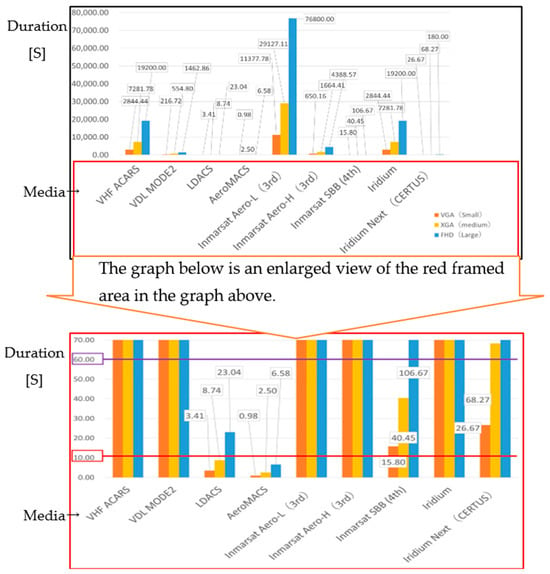
Figure 10.
Duration with high-quality image data for monotone.
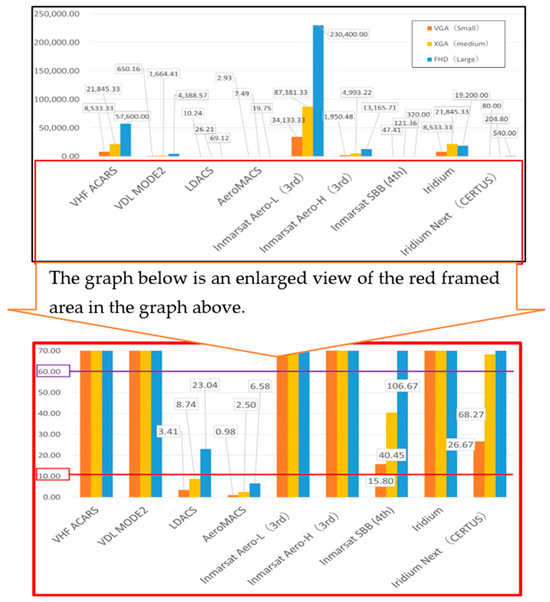
Figure 11.
Duration with high-quality image data for color.
5.2. Supply and Demand Analysis of Each Transmission Method
As part of a supply and demand analysis, we calculate how many aircraft can be processed for each form of media. As shown in the following formula, the number of aircraft that can be processed is calculated by dividing the communication performance required time by the duration (transmission time) per message, as mentioned above:
Us = ((Bs × Te)/Vs)/Rs
- Us: Aircraft numbers/units
- Bs (bps): Transmission speed
- Te (%): Transmission efficiency
- Vs (bits): Data volume
- Rs (s): Required communication performance
Table 4 and Figure 12 summarize the number of aircraft that will be sufficient to satisfy the communication performance requirements for flight plan data, ATC (CPDLC), and NOTAM (volcanic ash information). As shown above in the analysis of usefulness as a transmission method, the communication performance requirements for flight plan data and NOTAM (volcanic ash information) had not been defined, so they were similarly calculated as 10 s and 60 s.

Table 4.
Number of aircraft sufficient to satisfy the communication performance requirements for flight plan data, ATC (CPDLC), and NOTAM (volcanic ash information).
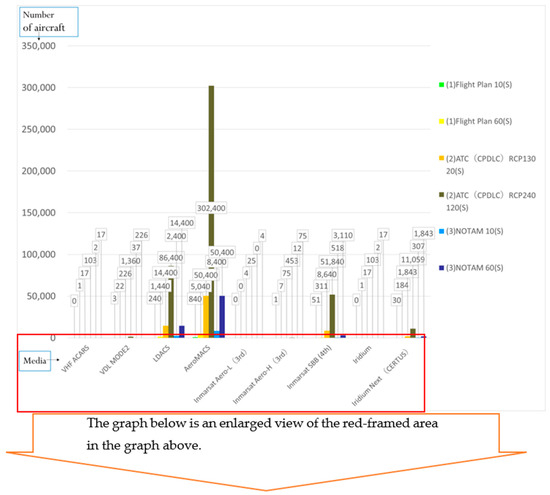
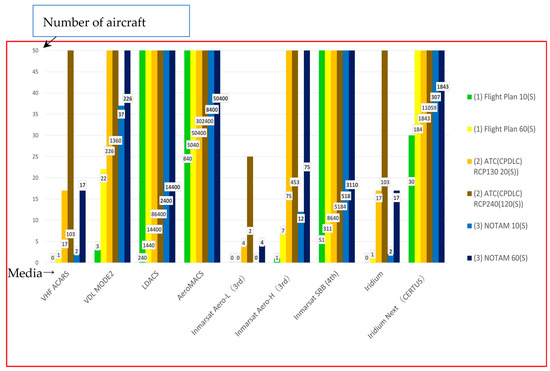
Figure 12.
Number of aircraft sufficient to satisfy the communication performance requirements for flight plan data, ATC (CPDLC), and NOTAM (volcanic ash information).
According to the results, for (1) flight plan data, when the required performance was 10 s, the number of suitable aircraft was extremely small, at less than 5 for VHF ACARS, VDL MODE2, Inmarsat Aero-L&H (3rd), and Iridium Next. Even when the required performance was more relaxed, allowing 60 s, there was only a slight improvement. For (2) air traffic control (ATC) communications via CPDLC, the required communication performance for continental airspace—defined as RCP130 [50]—was achieved with single-digit performance margins when using Inmarsat Aero-L (3rd generation). However, for other communication technologies, including those supporting RCP240 [51], the results demonstrated an ability to achieve performance metrics exceeding double-digit margins, indicating sufficient capacity to meet the required standards. For (3) NOTAM (volcanic ash information), the results were almost identical to (1) flight plan data for 10 seconds, but improved in 60 seconds, with the lowest number of Inmarsat Aero L&Hs (3rd) with 4 and others in the double digits or more.
The number of aircraft that meet the communication performance requirements for high-quality image data is summarized in Table 5 and Figure 13. According to the results, the number of aircraft was almost zero in all media except LDACS [35] and AeroMACS [36]. Also, in the case of color images, which have a larger amount of data, the number of aircraft needed was in the single digits, even with AeroMACS [36], at a resolution of XGA or higher.

Table 5.
Number of aircraft sufficient to satisfy the communication performance requirements for high-quality image data.
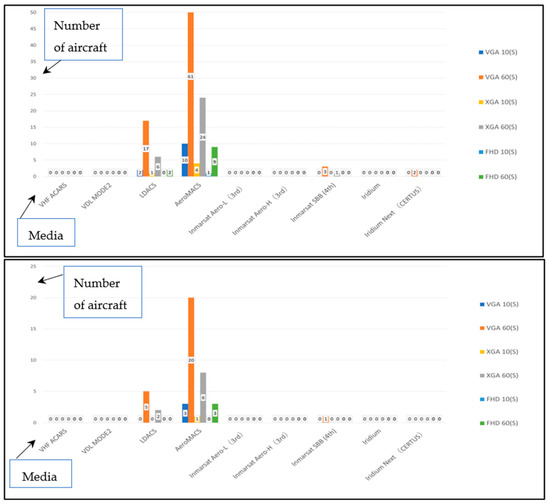
Figure 13.
Number of aircraft sufficient to satisfy the communication performance requirements for high-quality image data.
6. Consideration of the Use of Communication Technology in TBO [3], Based on the Results of the Supply and Demand Analysis
6.1. Issues Revealed by the Results of the Supply and Demand Analysis
From the supply and demand analysis, we found that the four media that could meet all communication performance requirements for flight plan data, ATC (CPDLC), and NOTAM (volcanic ash information) in the TBO [3] demonstration scenario and could communicate with more than 10 aircraft were as follows: LDACS [35], AeroMACS [36], Inmarsat 4th generation SBB, and Iridium Next. However, LDACS [35] is only available over continental areas, and AeroMACS [36] is only available over airport surfaces, so the only two communication technologies that can be used for the whole period from before departure to arrival are the Inmarsat 4th generation SBB and Iridium Next. Since these two media are satellite communications, it is only natural that they can be used borderlessly. Furthermore, with regard to high-quality image data, it was found that under almost all conditions, the media that are currently available or will be available in the near future, other than LDACS [35] and AeroMACS [36], do not satisfy the performance requirements, and when handling color images, the duration exceeds 10 s. For these reasons, the challenges are dealing with the increase in the number of aircraft that can meet the required communication performance standards, and addressing the particularly long duration needed for handling image data. Another challenge is that all media transmit ATC (CPDLC) data, which requires time-critical communication performance, mixed with other information on a single channel. As a result, this will not only delay ATC (CPDLC) messages but also cause them to miss the opportunity to send out data if the communication channel is congested. This means that measures must be taken to avoid delays and line occupancy.
6.2. Proposals for Solving These Issues
In light of these challenges, a fundamental solution would be to address the communication capacity shortfall by significantly increasing transmission speeds. This advancement is anticipated to support fourth-generation and future gigabit-class communications—comparable to those already achieved in mobile networks. However, as previously noted, such technological developments are not expected to be operational until around 2030, which aligns with the ICAO’s projected timeline for the implementation of TBO [3].
Consequently, it is essential to optimize the use of currently adopted communication technologies within the constraints of the existing infrastructure. To this end, we propose the following solutions, building upon the methodology and findings of a previous study [48].
- (1)
- Increasing the capacity of the communication channels to handle an appropriate number of aircraft
Increasing the number of communication channels or combining wiith other communication technologies can achieve an increase in communication capacity. From the perspective of investment in aircraft equipment and communication infrastructure by air traffic control agencies, increasing the number of communication channels is easier and more feasible to introduce than using a combination of other communication technologies because there is less risk in technological development. However, when adopting this approach, one must also ensure the availability of spectrum/frequency resources. Combining different media is also a reasonable solution because frequency resources can be used effectively, and optimal communication technology can be used in the flight area. However, it is challenging to equip avionics with the media and investment infrastructure suitable for air traffic control agencies. In addition to the development and introduction of media-switching methods, specific technology is also necessary.
- (2)
- Mitigate transmission delays
As shown in the demand and capacity analysis, in the case of color images with FHD resolution, which maximizes the amount of information, it was evident that Inmarsat 3G (High) requires approximately 4 h to transmit the data; however, LDACS [35] requires only approximately 1 min and AeroMACS [36] requires only approximately 20 s. As mentioned above, based on coverage, LDACS [35] has restricted its use to only continental areas, and the use of AeroMACS [36] is limited to airport areas only. The research of Kazuyuki Morioka [43] et al. on the introduction of a switching technology between different aviation communication systems is expected to provide an effective solution. Another potential approach to mitigating this issue is the reduction of data volume through the following methods.
- Image compression technology
By employing standard image compression algorithms, such as those developed by the Joint Photographic Experts Group (JPEG), the data volume can be reduced to less than one-tenth of the original size [52].
- Operational ingenuity
Data volume can also be minimized by distinguishing between monochrome and color images and by selecting the appropriate image resolution, based on the operational requirements.
- (3)
- Considering time-critical data link control communication
As mentioned above, data link communication for ATC (CPDLC) requires time-critical performance compared with other messages/data. Therefore, it is necessary to take measures to prevent message delays and stop other messages/data from monopolizing the lines. As a countermeasure to this issue, introducing priority control is essential. In other words, data link communication for ATC (CPDLC) requires that even if other messages/data are being transmitted, this can be interrupted and the ATC data given priority for transmission.
6.3. Scenario for Effectively Utilizing Communication Technology with Improvement Measures
Regarding the utilization of the improvement measures described above, we propose the scenario presented in Table 6 to effectively utilize communication technology during TBO [3].

Table 6.
Effective utilization of communication technology during TBO [3].
As a suitable implementation image, a conceptual diagram of seamless open-land SWIM [2] access is presented in the demonstration experiment to realize a secure aeronautical radio system, which represents a basic study on the ground, as studied by Kazuyuki Morioka et al. [43]. A schematic of its implementation is shown in Figure 14. However, the supply and demand analyses revealed that using ACARS and VDL in the land area shown in this image resulted in delays; therefore, the use of LDACS [35] was recommended for this study. In addition to LDACS [35], AeroMACS [36] is recommended for airports as a communication technology that can be used without delay.
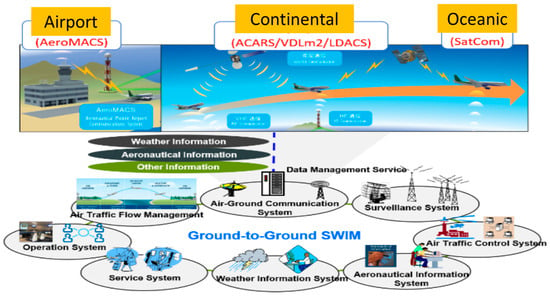
Figure 14.
Conceptual diagram of the seamless open-space SWIM [2] access [43].
6.4. Challenge of Implementation and the Need for Efforts Toward Finding Solutions
Regarding the cost analysis, in terms of the investment risk with introduction (as shown in the arrangement of transmission means), the faster the communication technology, the more expensive the introduction cost. In addition, as shown in Table 3, the onboard equipment for LDACS [35] and AeroMACS [36] has not yet been commercialized, raising concerns regarding the practical feasibility of these technologies. However, in terms of operation, we assume that a sustainable cost-sharing strategy is required because communication costs generally increase as the amount of communication increases. For these reasons, as a risk-mitigation measure for implementation costs, clarifying the technologies required for these measures and encouraging the realization and dissemination of the technologies necessary to obtain the benefits of these measures are advantageous, as reported earlier in this study. Regarding the operational costs incurred by communication service providers, by proposing that users use their services quantitatively, it is possible to secure stable long-term telecommunication demand, thereby reducing implementation risks. For users, it is expected that the risk of bearing costs will be reduced by allowing communication service providers to pay for such communications at a fixed rate, regardless of the amount of communication. These measures are interrelated, and we believe that by implementing both, a more stable and sustainable operation can be developed.
7. Conclusions
By utilizing the TBO [3] demonstration scenario, we can monitor the communication demand made by an actual flight, improve the accuracy of the supply and demand analysis, identify practical issues for social implementation, and confirm the effectiveness of such a demonstration, which is closer to reality. As a result of this supply and demand analysis, it was confirmed that for the flight plan data, ATC (CPDLC), and NOTAM (volcanic ash information) required for TBO [3], the Inmarsat 4th generation SBB and Iridium Next can be used by a double-digit number of aircraft, meeting the communication performance requirements from pre-flight to arrival. In contrast, for high-quality image data, most media other than LDACS [35] and AeroMACS [36] could not meet the requirements, and, in the case of FHD color, which involves the largest amount of data and a performance requirement of 10 s, the number of aircraft that could be supported was zero for all media. Furthermore, this study highlights the need to consider the potential risk that when all messages and data are transmitted via a single communication channel, time-critical communications such as ATC (CPDLC) may experience delays or may become unavailable, due to the congestion of channels caused by the transmission of non-critical messages or data. To address these issues, this study proposes introducing priority control for time-critical communications and utilizing all media, rather than simply increasing the number of channels to increase supply. In addition, it was suggested that the introduction of these solutions would require the development of media handover technology and the consideration of cost-effectiveness. However, it is expected that the solutions proposed in this study will be effective in addressing the trend of increasing amounts of information. Finally, it is hoped that this study will contribute to the spread of communication technology related to air traffic and the promotion of the development of new technologies.
Author Contributions
Conceptualization, N.H. and T.H.; methodology, N.H.; software, N.H.; validation, N.H. and T.H.; formal analysis, N.H.; investigation, N.H.; resources, N.H. and T.H.; data curation, N.H.; writing—original draft preparation, N.H.; writing—review and editing, N.H. and T.H.; visualization, N.H.; supervision, T.H.; project administration, N.H. and T.H.; funding acquisition, T.H. All authors have read and agreed to the published version of the manuscript.
Funding
This research was funded by Grants-in-Aid for Scientific Research <KAKENHI> of Japan Society for the Promotion of Science, grant number: 23K22878.
Data Availability Statement
The original data presented in the study are openly available. Publicly available data can be acquired through the links provided in the references.
Conflicts of Interest
The authors declare no conflicts of interest.
References
- Global Air Navigation Plan (GANP). Available online: https://www.icao.int/airnavigation/pages/ganp-resources.aspx (accessed on 31 March 2025).
- System Wide Information Management (SWIM). Available online: https://www.icao.int/APAC/Pages/swim.aspx (accessed on 28 May 2025).
- Global TBO Concept, Trajectory-Based Operation (TBO). Available online: https://www.icao.int/airnavigation/tbo/Pages/Why-Global-TBO-Concept.aspx (accessed on 31 March 2025).
- Long-Term Vision for Future Air Traffic Systems, CARATS, Collaborative Actions for Renovation of Air Traffic Systems. Available online: https://www.mlit.go.jp/koku/carats/en/ (accessed on 31 March 2025).
- Guo, X.; Li, J.; Peng, Z. Research on the Impact of TBO on Airline Planning and Scheduling. In Proceedings of the 2021 4th International Conference on Robotics, Control and Automation Engineering (RCAE), Wuhan, China, 4–6 November 2021. [Google Scholar]
- Correas, A.; Chen, C. Passenger object data service for end-to-end trajectory based operations. In Proceedings of the 2018 Integrated Communications, Navigation, Surveillance Conference (ICNS), Herndon, VA, USA, 10–12 April 2018. [Google Scholar]
- Lu, X.; Morioka, K.; Kanada, N.; Koga, T. 4D Trajectory Negotiation to Achieve Situational and Operational Awareness for Air Traffic Management. In Proceedings of the 2023 IEEE 15th International Symposium on Autonomous Decentralized System (ISADS), Mexico City, Mexico, 15–17 March 2023. [Google Scholar]
- Klein, R.; Abraham, B.; Morales, A.; Niewoehner, K.; Aknine, F.; Pace, J. Aircraft access to SWIM—A collaborative ATM pathfinder to support a TBO environment. In Proceedings of the 2015 Integrated Communication, Navigation and Surveillance Conference (ICNS), Herdon, VA, USA, 21–23 April 2015. [Google Scholar]
- Abraham, B.; Klein, R. AAtS: A collaborative ATM pathfinder in support of a TBO environment. In Proceedings of the 2015 Integrated Communication, Navigation and Surveillance Conference (ICNS), Herdon, VA, USA, 21–23 April 2015; Available online: https://ieeexplore.ieee.org/document/7121330 (accessed on 28 May 2025).
- Ngo, T.; Zuniga, A.; Biel-Goebel, J.J.; Miller, M.E. Technical Evaluation of FF-ICE/R2. In Proceedings of the 2019 Integrated Communications, Navigation and Surveillance Conference (ICNS), Herndon, VA, USA, 9–11 April 2019. [Google Scholar]
- Liang, D.; Ngo, T.; Biel-Goebel, J.J.; Masarky, S.; Miller, M.E.; Fullmer, I. Operational & Technical Evaluation of The FF-ICE/Execution Strategic Phase Across Boundaries. In Proceedings of the 2021 Integrated Communications Navigation and Surveillance Conference (ICNS), Dulles, VA, USA, 19–23 April 2021. [Google Scholar]
- William, D.; Krishna, S.; Tejasen, K.T.J. Flight Object Management Capability: Foundation for Flight Information Management Strategy. In Proceedings of the 2022 Integrated Communication, Navigation and Surveillance Conference (ICNS), Dulles, VA, USA, 5–7 April 2022. [Google Scholar]
- Saraf, A.; Laroza, R.; Popish, M.; Patel, A.; Chan, K.; Schade, J.; Finder, C. A Machine Learning-Based Decision Support Tool for Integrated Metroplex Departure Traffic Management. In Proceedings of the 2021 IEEE/AIAA 40th Digital Avionics Systems Conference (DASC), San Antonio, TX, USA, 3–7 October 2021. [Google Scholar]
- Hunter, G.; Fernandes, A. Leveraging new data exchange capabilities to improve trajectory predictions. In Proceedings of the 2017 IEEE/AIAA 36th Digital Avionics Systems Conference (DASC), St. Petersburg, FL, USA, 17–21 September 2017. [Google Scholar]
- Yan, Y.; Xue, T.; Liu, J.; Hu, H.; Cao, Y.; Dong, Y. Path Planning for a Greener Air Traffic Operation using RRT-based Algorithm. In Proceedings of the 2022 China Automation Congress (CAC), Xiamen, China, 25–27 November 2022. [Google Scholar]
- Zhang, L.; Cao, Y.; Yan, Y.; Mao, J.; Xue, T.; Dong, Y. Hybrid-A* based Path Planning Algorithm for a Greener Air Traffic Operation. In Proceedings of the 2022 China Automation Congress (CAC), Xiamen, China, 25–27 November 2022. [Google Scholar]
- Yu, K.; Kang, N.; Cai, K.; Li, W.; Chen, J. Analysis and Modeling of Air Traffic Trajectories Uncertainty in Chinese Airspace. In Proceedings of the 2020 AIAA/IEEE 39th Digital Avionics Systems Conference (DASC), San Antonio, TX, USA, 11–15 October 2020. [Google Scholar]
- Chen, Y.; Yang, L.; Zhang, H.; Zhao, Z.; Hu, M. Real-Time Autonomous Trajectory Conflict Detection and Resolution in Restricted Airspace. In Proceedings of the 2020 Integrated Communications Navigation and Surveillance Conference (ICNS), Herndon, VA, USA, 8–10 September 2020; Available online: https://ieeexplore.ieee.org/document/9223004 (accessed on 28 May 2025).
- Ramasamy, S.; Sabatini, R.; Gardi, A. Novel flight management system for improved safety and sustainability in the CNS+A context. In Proceedings of the 2015 Integrated Communication, Navigation and Surveillance Conference (ICNS), Herdon, VA, USA, 21–23 April 2015; Available online: https://ieeexplore.ieee.org/document/7121225 (accessed on 28 May 2025).
- Monteiro, L.B.; Ribeiro, V.F.; Garcia, C.P.; Filho, P.R.; Weigang, L. 4D Trajectory Conflict Detection and Resolution Using Decision Tree Pruning Method. IEEE Lat. Am. Trans. 2023, 21, 277–287. [Google Scholar] [CrossRef]
- Murça, M.C.R.; de Oliveira, M. A Data-Driven Probabilistic Trajectory Model for Predicting and Simulating Terminal Airspace Operations. In Proceedings of the 2020 AIAA/IEEE 39th Digital Avionics Systems Conference (DASC), San Antonio, TX, USA, 11–15 October 2020. [Google Scholar]
- Fang, Y.; Li, W.; Fang, Q.; Yang, Y.; Cai, K. An Integrated Clustering-based Approach for Aircraft Trajectory Generation Model. In Proceedings of the 2022 IEEE/AIAA 41st Digital Avionics Systems Conference (DASC), Portsmouth, VA, USA, 18–22 September 2022. [Google Scholar]
- Kuenz, A. Increasing the margins—More freedom in trajectory-based operations. In Proceedings of the 2014 IEEE/AIAA 33rd Digital Avionics Systems Conference (DASC), Colorado Springs, CO, USA, 5–9 October 2014. [Google Scholar]
- Fernandes, A.; Atkins, S.; Leiden, K.; Bagnall, T.; Kaler, C.; Evans, M. Taking trajectory based operations to the next level: Management by trajectory. In Proceedings of the 2018 Integrated Communications, Navigation, Surveillance Conference (ICNS), Herndon, VA, USA, 10–12 April 2018. [Google Scholar]
- Leiden, K.; Fernandes, A.; Atkins, S. Managing aircraft by trajectory: Literature review and lessons learned. In Proceedings of the 2018 Integrated Communications, Navigation, Surveillance Conference (ICNS), Herndon, VA, USA, 10–12 April 2018. [Google Scholar]
- Liang, D.; Sandhu, N.; Biel-Goebel, J.J.; Sherwin, R.; Samet, M. Evaluation of the Four-Dimensional Trajectory Live Flight Demonstration (4DT LFD) Project. In Proceedings of the 2021 Integrated Communications Navigation and Surveillance Conference (ICNS), Dulles, VA, USA, 19–23 April 2021. [Google Scholar]
- Sgorcea, R.; Symionow, W.; Balakrishna, M.; Becher, T. Integrating avionics standards with ground air traffic management systems to meet 2025 operational needs. In Proceedings of the 2016 IEEE/AIAA 35th Digital Avionics Systems Conference (DASC), Sacramento, CA, USA, 25–29 September 2016. [Google Scholar]
- Giles, S.L.; Zeng, D.; Chen, A.; Muraca, P.; Phillips, B. Transforming Today’s Closed Communications Network to Tomorrow’s Cross-Domain Aviation Internet. In Proceedings of the 2020 Integrated Communications Navigation and Surveillance Conference (ICNS), Herndon, VA, USA, 8–10 September 2020. [Google Scholar]
- Morioka, K.; Kohmura, A.; Yonemoto, N.; Jansen, L.J.A.; Mäurer, N.; Gräupl, T. Rapid Prototyping and International Validation Activity for the L-Band Digital Aeronautical Communications System (LDACS). IEEE Open J. Commun. Soc. 2023, 4, 2186–2203. [Google Scholar] [CrossRef]
- Gardi, A.; Sabatini, R.; Kistan, T. Multiobjective 4D Trajectory Optimization for Integrated Avionics and Air Traffic Management Systems. IEEE Trans. Aerosp. Electron. Syst. 2019, 55, 170–181. [Google Scholar] [CrossRef]
- Ayhan, S.; Wilson, I.; Comitz, P. Trajectory Based Operations / Unmanned Aircraft Systems with existing commercial avionics. In Proceedings of the 2016 Integrated Communications Navigation and Surveillance (ICNS), Herndon, VA, USA, 19–21 April 2016. [Google Scholar]
- Thomas, E.; Bleeker, O. Options for insertion of RPAS into the air traffic system. In Proceedings of the 2015 IEEE/AIAA 34th Digital Avionics Systems Conference (DASC), Prague, Czech Republic, 13–17 September 2015. [Google Scholar]
- Multi-Regional TBO Demonstration, Multi-Regional (MR) TBO Project. Available online: https://www.icao.int/APAC/Meetings/2023%20ATM%20SG%2011/03%20Multi-Regional%20TBO%20Demonstration.pdf (accessed on 31 March 2025).
- Liang, D.; Sandhu, N.; Kasper, K.; Sherwin, R.; Yang, S.; Mondoloni, S. Evaluation of the Multi-Regional Trajectory Based Operations (MR TBO) Live Flight Project. In Proceedings of the 2024 Integrated Communications, Navigation and Surveillance Conference (ICNS), Herndon, VA, USA, 23–25 April 2024. [Google Scholar]
- LDACS: L-Band Digital Aeronautical Communication System. Available online: https://www.eurocontrol.int/system/l-band-digital-aeronautical-communication-system (accessed on 28 May 2025).
- AeroMACS: Aeronautical Mobile Airport Communications System Datalink. Available online: https://www.eurocontrol.int/system/aeronautical-mobile-airport-communications-system-datalink (accessed on 28 May 2025).
- SESAR European ATM Master Plan. Available online: https://www.sesarju.eu/masterplan (accessed on 28 May 2025).
- SESAR. Available online: https://www.sesarju.eu/ (accessed on 28 May 2025).
- Next Generation Air Transportation System (NextGen). Available online: https://www.faa.gov/nextgen (accessed on 28 May 2025).
- The Integrated Communications Navigation and Surveillance (ICNS). Available online: https://i-cns.org/ (accessed on 28 May 2025).
- Sumiya, Y.; Ishide, A. Analysis and simulation of aeronautical satellite data communication traffic in oceanic airspace. IEICE Trans. Commun. 2010, 1666–1676. [Google Scholar]
- Kitaori, J.; Fujita, M.; Ishide, A. Characteristics of aeronautical satellite data communication in Japanese. Tech. Rep. IEICE. SANE 1998, 65–72. [Google Scholar]
- Morioka, K.; Kohmura, A.; Yonemoto, N.; Xiaodong, L.; Kanada, N.; Sato, M.; Miyazaki, N. Study status regarding next-generation multilink aero-nautical radio systems in Japanese. In Proceedings of the 23rd Electronic Navigation Research Institute Research Presentation; Electronic Navigation Research Institute: Tokyo, Japan, 2023; pp. 5–10. [Google Scholar]
- Eriza Hafid, F.; Markus, W. Capacity dimensioning for air traffic management (ATM) ser-vices in a spot beam satellite system. In Proceedings of the 2007 International Workshop on Satellite and Space Communications, Salzburg, Austria, 13–14 September 2007; IEEE: Piscataway, NJ, USA, 2007; pp. 65–72. [Google Scholar]
- Hasan, M.M.; Rahman, M.A.; Arya, S.; Ana, U.K.; Taufiq, A.; Hai, T.; Suraya Abu, B. Search and rescue operation in flooded areas: A survey on emerging sensor networking-enabled IoT-oriented technologies and applications. Sci. Cogn. Syst. Res. 2021, 67, 104–123. [Google Scholar] [CrossRef]
- Lakshmana, R.K.; Quoc-Viet, P.; Firoz, K.; Jalil, M.P.; Kapal, D. Blockchain for securing aerial communications: Potentials, solutions, and research directions. Sci. Phys. Commun. 2021, 47, 101390. [Google Scholar]
- Pankaj, K.; Sam, D.; Samar, S. Drone assisted device to device cooperative communication for critical environments. Wiley Orig. Res. Paper 2021, 15, 957–972. [Google Scholar]
- Hongo, N.; Hirata, T.; Habuchi, H. Basic analysis of supply and demand of digital satellite communications in air traffic management. J. Jpn. Soc. Aeronaut. Space Sci. 2022, 70, 48–57. [Google Scholar] [CrossRef]
- Regarding Throughput Improvement When Using Slotted Aloha as the Communication Method (In Japanese). Available online: http://www.soumu.go.jp/main_sosiki/joho_tsusin/policyreports/joho_tsusin/denpa_riyou/pdf/070419_1_s4.pdf (accessed on 31 March 2025).
- Baseline 2–RCP130/RSP160 Specifications (Continental Airspace), 2ndNAT/EUR PBCS Workshop, ICAO NAT/EUR PBCS Workshop-2. 2015. Available online: https://www.icao.int/EURNAT/Other%20Meetings%20Seminars%20and%20Workshops/NAT%20PBCS%20WORKSHOP/2nd%20NAT%20PERFORMANCE-BASED%20COMMUNICATIONS%20AND%20SURVEILLANCE%20WORKSHOP/NAT%20PBCS%20Wkshp-2%20PPT14.pdf (accessed on 31 March 2025).
- RCP240,RTCA SC-222 Final Review and Comment Version of Generic, MASPS for AMS(R)S Services in Procedural Airspace Including Swift Broadband-Specific Material, Aeronautical Communications Panel Twentieth Meeting of Working Group M. 2013. Available online: https://www.icao.int/safety/acp/ACPWGF/ACP-WG-M-20/ACPWGM-20-WP05%20FRAC%20MASPS%20and%20SBB%20Material.pdf (accessed on 31 March 2025).
- Image File Formats (In Japanese). Available online: https://itmemogaki.cloudfree.jp/pc/image-file.html (accessed on 31 March 2025).
Disclaimer/Publisher’s Note: The statements, opinions and data contained in all publications are solely those of the individual author(s) and contributor(s) and not of MDPI and/or the editor(s). MDPI and/or the editor(s) disclaim responsibility for any injury to people or property resulting from any ideas, methods, instructions or products referred to in the content. |
© 2025 by the authors. Licensee MDPI, Basel, Switzerland. This article is an open access article distributed under the terms and conditions of the Creative Commons Attribution (CC BY) license (https://creativecommons.org/licenses/by/4.0/).